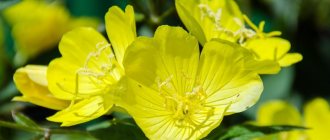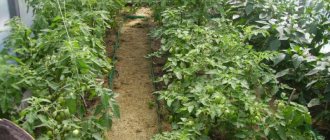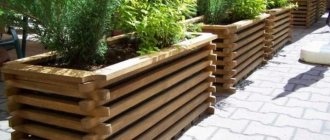Brief description of the Salpiglossis plant
Salpiglossis: photos of flowers
Salpiglossis is a very diverse flower of the nightshade family. It unites more than twenty species, which, it would seem, is not such a huge number, however, given the huge number of different varieties that are bred every year, any florist will definitely be able to find Salpaglossis to his liking.
Among the Salpiglossis flowers you can find both annual, biennial and perennial plants. It grows in South America and is practically not found in the wild anywhere except Chile.
By the way, the name of this plant also has a rather interesting origin. From Greek it is translated as “pipe” and “tongue”. And, if the word trumpet in this name is really justified, because the flower itself is very similar to a musical trumpet, then the word tongue is rather unobvious, since nothing in the structure of the plant hints at the presence of any kind of language. However, this flower was popularly called trumpet tongue, and it has been widely used in gardening and landscape design since the 1820s.
Salpiglossis flowers - features
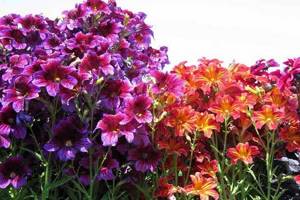
Salpiglossis: photo of flowers in a flowerbed
Unfortunately, despite the fairly wide variety of species of this genus, only one of them managed to become truly popular and widely used among gardeners, and it is called Salpiglossis notched. All other species grow mainly exclusively in the wild, but many gardener-collectors still value them very much and give them a special place in their plots.
However, we will be describing Salpiglossis notmata, since most likely, if you decide to get this flower, your garden will be replenished with a representative of this species. The shoots of Salpiglossis notched can reach a meter in height, but the length still varies, and therefore can be either greater or less. The shoots themselves are quite thin, especially for their size, and they also have a branched structure. In addition, small hairs can be found on their surface.
As for the leaves, they are quite narrow and face down. This especially applies to those leaf plates that grow closer to the buds. In addition, it should be noted that they are quite narrow, and therefore in the early stages of growth it may seem that the young leaf is a new branch of the stem.
The flowers, as already mentioned, have the shape of a musical trumpet. Also, for many, their shape can be characterized by a gramophone tube. They are small and reach no more than five centimeters in diameter, but the color can be completely varied: from sky blue to scarlet red. Pink and purple buds are also found.
Flowering is quite long: it begins in early summer and continues until mid-autumn. At the end of flowering, capsule fruits are formed at the tips of the peduncles, which contain seeds with which the plant can be propagated quite simply.
As we have already said, this plant is found both as an annual and as a biennial or perennial. However, unfortunately, in our latitudes and climate it is simply not possible to grow perennial Salpiglossis, and therefore in garden stores you will most likely be able to find seeds of only annual or biennial individuals.
Fantastic salpiglossis - growing one of the most piquant flowers
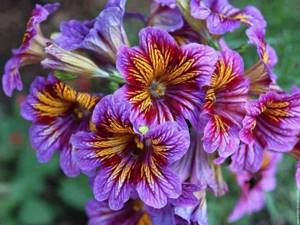
Salpiglossis is a flower with a special original image. With its sophistication of lines and exotic richness of colors, it resembles orchids, and its shape resembles bells. Elegant, slightly appealing, piquant, luxurious, extraordinary - it will decorate both the garden and the bouquet.
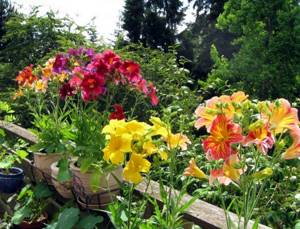
Herbaceous annual (or biennial - depending on the method of cultivation) with thin medium-leafed stems from 15 cm to 1 m in height. Flowers with a diameter of 6 cm, velvety, with contrasting veins, varied shades, mostly juicy, bright, neon: pink, crimson, yellow, red, lilac, blue, but there are also exquisite ones: white or brown with veins - it looks exotic.
Flowering is very long - the plant is covered with flowers all summer, as well as the warm part of autumn.
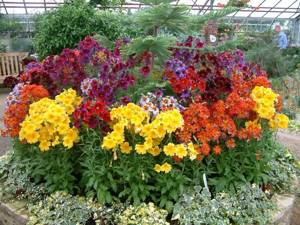
Salpiglossis: growing from seeds
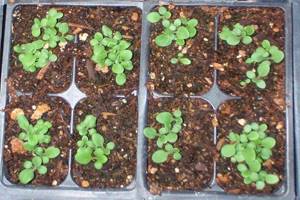
Salpiglossis: photo of growing from seeds
As already mentioned, Salpiglossis notmata seeds are one of the easiest and most effective ways to propagate Salpiglossis. In addition, no other method is practically used either by novice gardeners, or, especially, by experienced flower growers, and therefore we will consider exclusively the seed method.
When to plant Salpiglossis seedlings?
The best time to plant seeds is the very beginning of spring: mid to late March. For Salpiglossis seedlings, you will have to select special pots: they should not be too deep, since at the initial stages of development the plant will not have a very developed root system, but they should be wide enough so that more seeds can be planted and, accordingly, more seedlings can be obtained.
Sufficiently loose soil is used as a soil mixture, preferably with the addition of peat. However, soil for growing Salpiglossis seedlings is sold in any store, and therefore there should definitely not be any problems with it.
Once the pots are filled with soil, you can spread the seeds over its surface. To do this, you will have to place them as far as possible from each other, since otherwise neighboring sprouts will interfere with each other’s growth and development.
Another important point is that the seeds of Salpiglossis flowers do not need to be buried in the ground at all. In order for them to germinate well, you just need to press them a little into the soil. After all of the above procedures have been completed, the pot can be covered with film or even glass in order to create an artificial greenhouse effect, thanks to which the seedlings will develop much faster and more readily.
It is also important to observe the temperature regime. The best temperature for sprouts is between fifteen and twenty degrees, so they will need to be placed in the coolest place in your home. It is advisable to place it closer to the floor, since this is where all the cold air collects.
In addition, it is advisable to provide salpiglossis seeds with protection from scorching sunlight. It would seem that plants love the sun, but its excess can have a very detrimental effect on them, and therefore you can put a thin piece of paper on top of the film or glass (depending on what you decide to cover the pots with).
Salpiglossis in landscape design
Under natural conditions, about 20 species of exotic plants with original buds grow, but only one variety is used in the garden. Salpiglossis notmata is a plant for creating interesting compositions in a summer cottage, a flower bed near the house, next to coniferous plantings. The flower is grown in light, non-boggy areas.
An interesting combination is obtained when planting ground cover species (Lobelia) and Salpiglossis. The bright colors of the plant with gramophone buds complement the beauty of Marigolds, Nasturtiums, and Petunias. Salpiglossis is planted near coniferous species with bright greenery: Cypress, Spruce. Original compositions are obtained when using Chrysanthemums or flowers of the Liliaceae family as a companion plant.
Be sure to take into account the requirements for humidity, lighting, and soil moisture levels. It is necessary to take into account the flowering period of plants in landscape compositions so that the bright colors of Salpiglossis do not combine with the withered buds of plants, the degree of decorativeness of which decreases a month or two earlier.

The South American plant Salpiglossis is still less common in gardens than Asters, Lilies and Tulips, but the gardeners who planted the original species on the site do not regret their choice. Unpretentiousness combined with original buds and exotic “appearance” are factors that add points to the unique plant’s score. Even a novice gardener can decorate a garden or flowerbed with such an interesting species as Salpiglossis.
After watching the video, you can find out more useful information about planting Salpiglossis seedlings and the rules for caring for seedlings:
How to care for seedlings
The most important thing for seedlings growing, let’s say, under a hood, is not watering, but ventilation. Therefore, you should provide the salpiglossis seeds with streams of fresh air as often as possible, thanks to which you will not allow them to “suffocate” in their own pots.
If you did everything correctly, the first shoots will be noticeable within fifteen days. However, there is no need to worry if there is a delay of, for example, three to five days. This is absolutely normal.
Of course, it intuitively seems to us that as soon as this happens, it is better to remove the film immediately and, at the same time, for good, but this is fundamentally wrong, since for some time it is still better for the young bore to remain under its protection. However, it is still necessary to gradually prepare the seedlings for life in the open air, and therefore the protection will only need to be removed temporarily. First - for an hour, after a week - for three, and so on.
After the first true leaves appear on most of the seedlings, you can plant them in their own pots. Given the size of the plant, it is not necessary to take a whole pot for this. Even a small glass will do.
It is also important to be careful. The fact is that Salpiglossis seedlings have not yet formed a powerful root system, and therefore it is very easy to damage. Try to capture a large lump of earth together with the roots so that they are certainly not damaged.
For some time after picking, the growth of Salpiglossis seedlings will slow down significantly, but this is obvious and understandable - you just need to let it get used to the new environment. After about a week, growth will continue at the same pace, and then, by the way, the flower can be pinched at its very top. This way you will make the future bush much more lush and branchy.
In addition, young Salpiglossis sprouts, of course, need regular and fairly abundant watering, but excessive moisture can destroy the root system of the flower, so be careful.
Caring for seedlings (hardening, picking)
Seating from a common box is carried out during the appearance of a pair of real leaves. The picking is done very carefully so as not to damage the root system. The young plants are moved into peat humus pots so as not to create stressful situations for the plant anymore.
After transplantation, the specimens quickly begin to grow, and since the culture is high, it needs support. To do this, you can use supports for ordinary indoor flowers, which are sold in garden stores. After some time, it needs pinching in order to create more bushiness. If necessary, phytolamps are used.

Remember! Peat pots tend to dry out quickly, so it is better to place them in cut-off plastic bottles to retain moisture.
The hardening period begins from the moment the sprouts hatch. In this case, the film is not removed at all. At first, the window is opened for a short period of time, but so that there is no draft. Gradually, the time spent in the fresh air is increased, and the film is completely removed.

Salpiglossis flowers: planting and growing in open ground

As already mentioned, Salpiglossis flowers are grown mainly in the garden, and therefore, of course, all gardeners who cultivate this plant have reasonable questions related to how, where and when it is best to plant seedlings of this flower. We tried to answer all these questions and hope that you will no longer have any problems with planting Salpiglossis.
When to plant Salpiglossis?
The only condition that must be observed when planting this plant is the absence of return frosts. The fact is that it is they who most often take novice gardeners by surprise and do not allow them to grow a healthy and beautiful plant. Therefore, carefully monitor the weather and plant seedlings only when it becomes as stable as possible.
For those who are not particularly versed in the weather, but still want to plant Salpaglossis without losses and problems, we can advise planting this plant in open ground in the second half of May. If we look at recent years, it is at this time that the weather completely calms down and no cold weather threatens your plantings.
Where to plant Salpiglossis?
Speaking about the planting site, it should be noted that Salpiglossis is a rather demanding plant regarding this factor. The most important thing is good lighting of the place in which the flower will grow. In addition, it is imperative to provide protection from the wind, since otherwise the likelihood of a sudden disease that can easily destroy the plant increases significantly.
As for the soil, it should be the most nutritious and neutral in terms of acidity. All other factors are not so important, and therefore making the ideal soil mixture yourself is a rather futile exercise. Salpiglossis accepts almost any soil composition very well, and therefore you can simply buy it in the store.
How to plant Salpiglossis?
In fact, the planting process begins long before the Salpaglossis sprout directly enters the soil. About a week before, you need to completely dig up the area and rid it of weeds and large stones. If you did not use a ready-made soil mixture for planting Salpiglossis, then at this stage it is advisable to add peat, sand and humus to the soil.
Now that the soil has been dug up, you need to dig holes in it for seedlings. To ensure that Salpaglossis do not compete with each other for water and nutrients, and also that they do not interfere with the growth of each other’s root systems, it is necessary to place them at a distance of at least thirty centimeters from each other.
Now let's move on to the actual planting process. During this process, you must be careful and careful, since you are still working with plants whose root systems are not yet strong enough. Therefore, the earthen lump that has formed around the sprout must be handled carefully and carefully.
After the earthen lump is inside the hole, it needs to be thoroughly covered with earth. Of course, for the first few weeks or even months after planting, the plants require very close care, which, first of all, implies fairly abundant and regular watering.
It is important to remember that all of the above procedures and operations should be done as carefully and accurately as your abilities allow. Salpiglossis, as an extremely delicate and fragile plant, does not tolerate transplantation very well, and this is especially true at an early age. It is advisable not to touch its roots at all, having thoroughly walled them up in a lump of earth.
Insect pests and diseases
In open ground it is at risk of root and stem rot. They have the power to completely destroy the flower. As part of the fight, it is necessary to treat the surrounding area, and the bush itself, with fungicides. It is also necessary to adjust the watering regime. If the plant is severely affected, it will have to be completely removed from the garden bed.
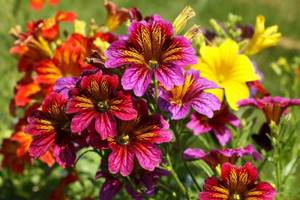
Among insects, its natural enemy is aphids, against which acaricides are effective.
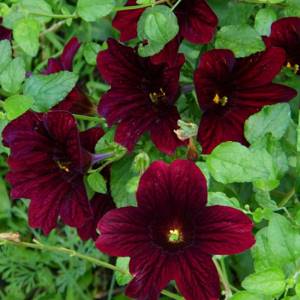
Salpiglossis: care
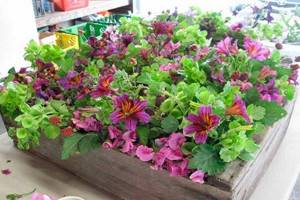
Salpiglossis: photo in the flowerbed
Of course, not only the planting of this plant is teeming with small nuances, failure to comply with which can lead to unpleasant consequences. Salpiglossis also requires very careful attention to self-care, and therefore you must follow the instructions below:
Watering
Salpiglossis should be watered as often as possible, since this plant does not tolerate drought at all and prefers to always have moisture around it. However, of course, like any other plant, Salpiglossis reacts extremely negatively to excessive stagnation of liquid, as this can lead to such an unpleasant disease as root rot.
In order to ensure Salpaglossis a carefree and pleasant existence, watering should be carried out at least once a day. In addition, not only the moisture in the soil, but also around the plant is of particular importance, and therefore, especially if it is unbearably hot outside, the leaves of the plant should be moistened in the evening. Otherwise they will dry out very quickly.
However, all of the above applied to summer watering. As for spring or autumn, you need to water the flower much less often at this time. In fact, two to three waterings per week should be sufficient.
Speaking about the qualities of water, it should be noted that it must be soft and settled. The flower reacts very negatively to other water, as it can harm its root system. By the way, you can also collect rainwater and water Salpiglossis with it.
However, the procedures related to watering do not end there. The fact is that after you have watered the plant, you also need to loosen the soil around it, at the same time getting rid of overgrown weeds.
However, this procedure can be completely avoided by resorting to mulching, which performs several useful functions at once: it retains water in the soil, protects the plant from weeds, and also prevents various snails and slugs from crawling onto it. However, of course, by resorting to this procedure, you will have to significantly change the flower watering schedule.
Trimming and pinching
Of course, pinching is not a mandatory procedure, which you simply cannot do without when growing this plant. However, it is very useful if you want to see the most lush and branched bushes on your site.
Pruning is required in the fall. It starts small, namely with cutting off dead flowers, which will gradually begin to fade a month before the end of flowering, since they also bloom unevenly.
Why is this procedure so important? The fact is that if you do not do it, the flower will still spend its energy and resources on maintaining the already dead flower. And, consequently, still healthy and blooming buds will receive a significantly smaller share than they could. This, of course, reduces the overall duration of flowering, and therefore pruning of faded buds is necessary.
Also, of course, if you observe diseased or drying shoots and branches, they also need to be pruned in a timely manner.
Top dressing
As a fertilizer for Salpaglossis, it is best to use a complex mineral fertilizer, since it will, for the most part, receive all organic substances directly from the soil. Fertilization is carried out several times per season, depending on how the growth process is progressing.
If you are a novice gardener, it is better to consult with a more experienced craftsman about when and how much fertilizer to give specifically to your Salpaglossis variety. Unfortunately, since the dosage and timing vary greatly from variety to variety, we can only give an average value: from two to four feedings.

Salpiglossis: photo
Joint planting and landscape design
Salpiglossis is unpretentious in choosing neighbors in the garden, so you can safely use it in the most unusual compositions and combinations of plants.
It looks beautiful and original surrounded by flowers that change with the seasons: marigolds, asters, chrysanthemums, roses, ornamental cabbage, lilies, phlox.
In landscape design, they are planted in the form of hedges, alleys, highlighting borders and recreation areas, in the form of ridges.
A plant such as salpiglossis will not leave more than one gardener indifferent due to its beauty and abundant flowering. Having planted it once, you will want to see the flower on your site every year and decorate it not only with your front garden, but also use it in the design of your apartment or the porch of your house.
Diseases and pests of Salpiglossis
You, of course, have already guessed that a plant that loves water so much will certainly develop various ailments, one way or another related to excess or lack of water.
The first such disease, of course, is root rot. This is a very unpleasant disease, which, fortunately, never occurs on its own. The reason for its occurrence is excessive watering, in which water lingers in the soil for too long and inevitably causes rotting of the roots.
Root rot is quite easy to detect: the plant immediately becomes very ill, it becomes dull and droops. In this case, you should treat Salpiglossis with a fungicide, since, as you probably know, it is the fungi that reproduce very well in humid environments that are the cause of this unpleasant disease.
However, sometimes it is not always possible to detect the disease in time. The reasons are different, but your actions in such a situation should be exclusively the following: the plant must be immediately dug up and burned, and all neighboring plantings are treated with a fungicide to prevent further spread of the infection.
A completely different issue is pests. They do not arise due to the gardener’s mistake or due to any external factors. The plant simply provides them with an excellent environment for reproduction and nutrition, and therefore they strive for it. The most frequently visited pest of Salpiglossis is the aphid, and if it is not stopped, it can personally destroy the entire planting.
In order to prevent aphids from eating all your Salpaglossis, you should inspect the leaf axils as often as possible, as well as the backs of the leaves, since the aphids know that you do not like them and hide. If a parasite is detected, the plant must be treated with an acaricide.
What to do after flowering?

Salpiglossis: photo
As already mentioned, as a perennial Salpiglossis in the garden it is not possible to cultivate it everywhere, namely in regions with a fairly mild and predictable climate. Most likely, you will not have a perennial or even a biennial, but an annual Salpiglossis. This means that after flowering you need to do something with it. Now you will find out that.
First of all, it should be said that simply leaving a bush in the ground to the mercy of fate is an extremely irresponsible and stupid idea. In winter, of course, it will die, and in the spring, when you want to plant something else in the same area, you will have a huge number of problems. Therefore, a completely faded bush must be dug up. However, he still has a chance to continue living.
If for some reason you planted a two-year or perennial Salpiglossis on your site, you still have a chance to save it from severe frosts. You probably already guessed what we are talking about: the plant can be brought into the house. However, this procedure will be tolerated extremely negatively by the plant, and the chances that it will survive depend solely on your experience and skills.
However, despite the fact that this operation should be carried out with the utmost knowledge of the matter and only experienced gardeners can do it, you can still try to pull it off. You may even succeed, but from now on, be careful about what type and variety you buy. By the way, about this:
Types and varieties of Salpiglossis

Salpiglossis: photo
As mentioned above, the only species that takes root relatively well in our harsh regions is Salpiglossis notched. We have already given its description, and therefore we see no point in repeating it.
However, despite the fact that this is only one species, our domestic cultivators and breeders have done a very good job of ensuring that this single species is as large and numerous as possible. Thus, many garden forms have appeared, among which are:
Large-flowered form . Of course, only after reading the name, anyone can understand how this subspecies of Salpaglossis differs. Of course, with its large flowers, which are almost one and a half times larger than the size of the flowers of the mother species. However, in other respects, the large-flowered notched Salpiglossis is practically no different from its ancestor.
Salpiglossis superbissima . The differences between this subspecies and the maternal one, unlike the previous one, are quite difficult to understand from the name. Therefore, obviously, explanations are required. Firstly, Salpiglossis Superbissima also has enlarged flowers, and secondly, these Superbissima flowers differ significantly from those that crown the peduncles of Salpaglossis notched. The difference is that these have corrugated petals, and therefore look much more elegant and interesting.
Salpiglossis low . Again, the obvious name. Of course, the difference between this subspecies is its size. And, of course, it is not suitable for all gardeners, because among us there are both those who adore miniature plants and those who prefer larger dimensions. However, in addition to dwarfism, this garden form of Salpaglossis has another distinctive feature: it blooms very luxuriantly.
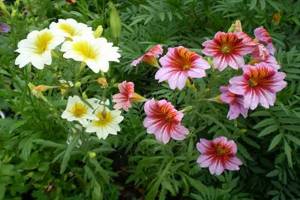
Salpiglossis: photo
Now let's talk about varieties, both natural and hybrid, since they sometimes represent much greater diversity than even subspecies. Among the most popular varieties are the following:
- Q Blue . This Salpiglossis is undersized, and therefore, of course, not everyone will like it, as we have already said. Its height reaches only a third of a meter. However, this variety also has something for which almost any gardener will definitely like it, and this is the palette. Q Blue buds are painted in completely different colors: from sky blue to purple. In addition, on the surface of absolutely any petal you can find a beautiful grid-like pattern.
- Casino Mix . This variety is also quite short, and its height does not exceed half a meter. However, this variety simply needs support, as its stems are very delicate and fragile. As for the color of the buds, it can be completely different: pink, blue and even yellow.
- Festival and Flamenco . This variety is very similar to the previous one in terms of color, but differs significantly in terms of height. Its stems do not grow higher than a third of a meter, but they do not require support.
- Bolero . It reaches a height of more than six tenths of a meter, but the stems are quite strong and strong, and therefore do not need any support. Color is still extremely varied.
- Salpiglossis Ali Baba . A rather exotic variety that differs from the rest in very unusual and variegated patterns on the surface of the petals. It should also be noted that Salpiglossis Ali Baba reaches a height of up to eight tenths of a meter, and its stems are stable.
- Velvet Dolly . This variety is distinguished by its beautiful, lace-like flowers. In addition, they are quite large and reach a diameter of six centimeters. Their coloration, however, is quite limited and varies from blue to purple. As for the height, the stems of Velvet Dolly do not grow more than half a meter.
- Fireworks . Salpiglossis Fireworks is simply incredibly lush and branchy. Despite its height of sixty centimeters, Salpiglossis Fireworks has a simply stunning width and a large number of buds. It is thanks to its splendor, by the way, that this variety got its name. As for the coloring, it is quite interesting, since one Salpiglossis Fireworks can be painted in several shades at once, passing into each other in a gradient.
- Magic . This rather cute name fully describes this variety. Its height is never less than half a meter, and its color is truly snow-white. Purple specimens are also found, but they are rare.
Of course, there are still a huge number of varieties, but they are either very similar to the above or do not deserve attention at all.
Types, varieties
In common parlance, the South American guest is called a tubetongue. Although this plant has many varieties, the one most often used in floriculture is the notched one. The height of this variety varies from fifteen centimeters to one meter, and is valued due to the variety of bright colors. It has a variety of petal shapes and is divided into three subspecies:
- short - does not exceed a meter in height, has lush inflorescences;
- large-flowered - has large caps, tall appearance;
- superbissima - the variety reaches a meter in height, has corrugated petals.
Among the above varieties, the following hybrids can be distinguished:
- Q Blue F1 - has only purple shades of color, with a dark core and yellow veins. This species reaches half a meter in height. Suitable for breeding in apartment conditions, winter gardens, greenhouses.
- Splash F1 – sold as a mixture. Although the bushes reach a meter in height, they are grown indoors. Differs in a variety of colors.
- Bolero F2 – available for sale in mixtures. Designed for both outdoor and indoor cultivation. Can take root in shaded areas of the garden. The bushes reach a height of fifty centimeters.
- Casino F1 - this variety is good for container growing and arranging bouquets. The bushes do not exceed a meter in height. The specimen branches well and has a bright color. It is presented in gardening stores as a mixture.
- Glumi Rival is one of the species that does not have noticeable veins on the inflorescence. Has pink and purple colors.
- Royal - the height of the variety does not exceed a meter. It has scarlet, purple and blue colors.

